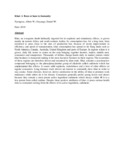Khat: A Boon or bane to humanity

Date
2010Author
Nyongesa, Albert W.
Onyango, Daniel W.
Type
ArticleLanguage
enMetadata
Show full item recordAbstract
Khat, an evergreen shrub habitually ingested for its euphoric and
stimulatory effects, is grown mainly in eastern Africa and south-western
Arabia. Its consumption has, for a long time, been restricted to areas
close to the sites of production but, because of recent improvement in
efficiency and speed of transportation, khat consumption has spread to far
flung lands such as North America, Canada, Australia, United Kingdom
and parts of Europe. In regions where it is grown, daily life seems to
centre on the crop bringing together farmers, traders, middle men,
consumers and transporters. Thousands of dollars change hands daily in
market centres where khat business is transacted making it the most
lucrative business in these regions. The economies of these regions are
therefore driven and sustained by khat trade. Khat contains a psychoactive
compound belonging to the phenylpropylamine group of alkaloids called
cathinone which has amphetamine-like effects. It causes mild euphoria,
wakefulness and a host of other effects on regular consumers. Long distance
truck drivers are known to constantly chew khat in order to stay awake.
Some chewers, however, derive satisfaction in the ability of khat to promote
work endurance while others do it for leisure. Consumers generally prefer
young leaves and shoots because they contain a more potent active
ingredient cathinone which decays within 48 h to a less potent form called
cathine. Despite these positive attributes of khat, it poses serious health
risks to consumers arising from the effects of its active ingredient, cathinone,
Citation
Ethnomedicine: Source & Mechanism RPMP Vol. 28Publisher
Faculty of Veterinary Medicine
